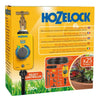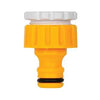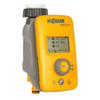Irrigation Timers Made Easy: Set-And-Forget Watering For UK Gardens

Irrigation Timers Made Easy: Set-And-Forget Watering For UK Gardens
If you are tired of guessing when to water, an irrigation timer can be the calm, reliable helper your garden needs. Set it once, then let it run sensible schedules that suit cooler, changeable UK weather. In this guide, you will learn how to choose a timer, how to programme it for autumn into winter, and how to avoid common pitfalls like overwatering, flat batteries, and low pressure. We will also share clear example schedules for lawns and beds, plus simple troubleshooting tips to keep things running smoothly.
Timer types explained
- Single zone tap timers. Simple and affordable. Ideal for one hose line feeding a small bed, pots, or a single sprinkler. Choose a model with clear dials or a basic display and a manual override button for quick watering.
- Multi zone timers. Great when you have lawn sprinklers plus separate beds. Each zone has its own start times and durations, so you water grass differently to borders.
- Digital tap timers. Offer weekday scheduling, multiple start times per day, rain delay buttons, and seasonal adjust. Perfect for shoulder seasons when you want finer control.
- Smart timers. Connect to an app, sometimes with optional moisture probes or flow meters. Useful if you travel or want leak alerts, but not essential for most gardens.
If you prefer Hozelock compatibility, look for a water timer Hozelock option with easy programming, reliable valves, and straightforward fittings that work with your existing hose and connectors.
How to choose an irrigation timer
Start with your layout and water source.
- Zones. If you run a lawn sprinkler and a separate drip line, a multi zone unit saves hassle. For one small area, a single zone timer is enough.
- Pressure and flow. Lawns need more flow than drip lines. Check your tap flow rate with a simple bucket test. If you plan to run several sprinklers, consider one zone at a time to avoid starving pressure.
- Features you will use. A rain delay button, manual watering, and multiple start times are more useful than fancy dashboards. If you want remote control or leak notifications, a smart model is worth it.
- Power. Most tap timers use AA or 9V batteries. Choose a model with a low battery indicator and weather-sealed compartment.
What is the best garden hose timer? The best one is the unit that matches your zones, gives you clear control of run times and days, and fits your existing Hozelock fittings without adapters. Reliability and easy, visible programming beat extra features you will never touch.
How to set a Hozelock timer
Here is a simple, step by step approach that fits most Hozelock timers.
- Fit fresh alkaline batteries, then attach the timer to your outdoor tap. Use Hozelock hose fittings on the outlet for a leak-free connection.
- Set the current time and day.
- Choose start times. One early morning start is usually enough in autumn. Add a second start only for very free draining soils.
- Set run time per zone. Lawns typically need longer than beds.
- Select watering days. In shoulder season, start with 2 to 3 days per week rather than daily.
- Use the rain delay button after heavy showers. Resume automatically the next cycle.
- Test run. Use manual watering to check open and close, then inspect emitters and sprinklers for even coverage.
Need help matching a timer to your setup? Our team can advise on Hozelock watering timer options and multi outlet choices that suit your garden without overcomplicating things.
Programming basics for autumn into winter
Cooler, shorter days mean soil holds moisture longer. You can cut back both frequency and run time.
- Lawns. Early morning only, to reduce evaporation and fungal risk.
- Beds and borders. Short, targeted sessions, especially for perennials and new plantings.
- Pots. Quick, more frequent bursts if they are under cover or in windy spots.
Use the rain delay whenever you get steady rainfall. In many UK regions, a 24 to 72 hour delay is enough. If your timer has seasonal adjust, reduce to 50 to 70 percent from your summer baseline.
Example schedules for Summer season
These examples assume reasonable water pressure, healthy soil, and no hose restrictions. Adjust to your site.
-
Lawn with one oscillating sprinkler.
- Start time: 6:00 am
- Days: Monday and Friday
- Run time: 20 to 25 minutes
- Tip: If water pools, drop to 15 minutes and add a third day.
-
Mixed beds on drip irrigation.
- Start time: 6:15 am
- Days: Tuesday and Saturday
- Run time: 12 to 15 minutes
- Tip: For newly planted shrubs, add a second start at 6:45 am for 5 minutes.
-
Patio pots on micro drip.
- Start time: 7:00 am
- Days: Monday, Wednesday, Friday
- Run time: 6 to 8 minutes
- Tip: If pots are sheltered from rain, keep frequency higher, but cut minutes as temperatures fall.
Prevent over or underwatering
- Look at the soil, not just the timer. Probe 5 to 8 cm down. Aim for evenly moist, not wet.
- Break sessions into shorter bursts on slopes to reduce runoff.
- Group plants with similar needs on the same zone.
- In cooler months, prioritise deep but infrequent watering for beds.
- Trim run times after rain and when temperatures drop below 10°C.
- Use mulch in beds to extend the gap between cycles.
Do water timers increase water bills? A well set timer usually reduces your bill by preventing waste. Overwatering often costs more than the water used by right sized, scheduled cycles.
Batteries, care and winter safe settings
How long do batteries last in irrigation timers? With good alkaline AA or a fresh 9V, expect 6 to 12 months in typical UK use. Cold snaps shorten life, so replace in early spring and check again in late autumn. Keep the compartment dry and close the seal snugly.
Before frost, do this.
- Reduce schedules to minimal maintenance watering, or pause entirely once plants go dormant.
- Use the timer’s off mode or rain delay to suspend watering when hard frosts are forecast.
- Disconnect downstream kit, drain hoses, and lift any low points so water clears the line.
- If possible, remove the timer and store it indoors. If it must stay on the tap, leave it empty of water and use a cover.
Troubleshooting quick wins
- Timer not opening. Check batteries first, then clean the inlet filter. Make sure the tap is fully open.
- Low pressure or sprinklers not popping. Run one zone at a time. Straighten kinks in your garden hose and avoid long runs of small bore pipe.
- Timer closes too soon. Recheck run time settings, then inspect for debris in the valve or a partially blocked filter.
- Drip line uneven flow. Level the line where possible, flush the system, and check for crushed hose connectors.
Can smart irrigation detect leaks? Many smart timers or add on flow meters can spot unusual, continuous flow and alert you. For non smart setups, watch for constant dripping, unexplained wet patches, or the meter spinning when everything is off.
Simple setup checklist
- Test flow at the tap.
- Choose the right zones.
- Fit reliable Hozelock fittings and strainers.
- Programme start times for early morning.
- Add rain delay after wet days.
- Review once a week for the first month, then monthly.
Your next step
Timers should feel simple, not stressful. If you want a dependable, Hozelock compatible setup, explore our Hozelock watering timer range and multi outlet options. We can help you match a timer to your garden, choose the right accessories, and programme a schedule that saves water and keeps plants healthy. Prefer to chat first? Our expert team is ready with practical advice and clear answers.
P.S. If you are upgrading hoses at the same time, pair your timer with quality Hozelock fittings or a durable flexible hose for fewer leaks and smoother installation.







